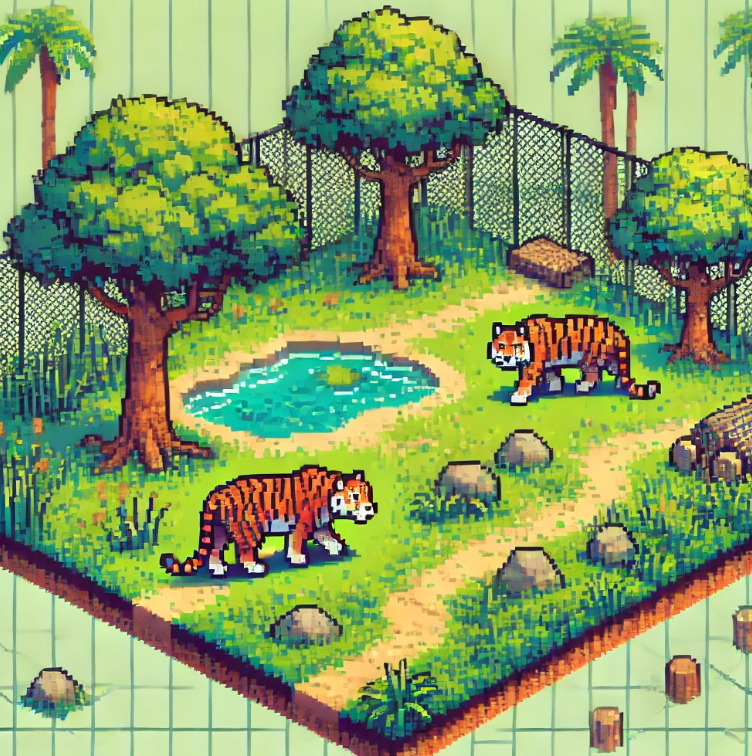
Trail Systems: The Key to Happier, Healthier Tigers in Zoos
Imagine living in a small room for most of your life, with little to do but pace back and forth. For some zoo animals, this is a harsh reality. But what if we could change that?
New research suggests that offering tigers larger, more complex spaces in zoos can lead to healthier, happier animals. The study, conducted over two years at Jacksonville Zoo and Gardens, explored the impact of a trail system that connects multiple enclosures on tiger behavior. The results are promising, and they offer valuable insights for both zoo managers and concerned pet owners looking for ways to improve the lives of their animals.
Why Tigers Need Space to Thrive
Tigers are big, solitary predators that patrol vast territories in the wild. These cats are hardwired to roam, explore, and hunt, often covering long distances in search of prey. In their natural habitat, tigers are crepuscular and nocturnal, meaning they’re most active during dawn, dusk, and nighttime. But life in captivity presents different challenges.
Without the need to hunt or patrol large areas, zoo tigers often develop stereotypical behaviors like pacing—a repetitive action that indicates boredom or stress. In fact, pacing accounts for 97% of abnormal behaviors recorded in captive carnivores. It’s easy to see why. Imagine being confined to a small space with nothing to do; you’d likely start pacing too. This is where innovative zoo designs come into play.
What the Research Found
The study at Jacksonville Zoo involved four tigers and examined their behaviors across three different exhibit configurations:
- One exhibit only (E): The baseline condition.
- One exhibit with a 19m² trail (ET).
- Two exhibits connected by a 46m² trail (E2T): The largest and most complex space.
Behavior was observed during both day and night over two summer seasons. Researchers found that giving tigers access to larger, more complex environments (E2T) significantly improved their overall welfare. Tigers in the E2T setup exhibited more active and exploratory behaviors, such as sniffing and cheek rubbing, and less pacing. These tigers also showed increased activity at night, mirroring the natural nocturnal patterns observed in wild tigers.
The Importance of Choice and Exploration
One of the most interesting findings from the study was the importance of giving tigers choices. When tigers had access to more spaces and the freedom to move between them, their natural behaviors—like sniffing new areas and rubbing against objects—came to life. These behaviors aren’t just about physical activity; they’re also tied to mental stimulation.
In the wild, tigers must constantly explore their environment, sniff out potential threats or food, and mark their territory. Providing zoo tigers with a trail system and multiple exhibits gave them the opportunity to mimic these natural instincts. By encouraging tigers to explore new spaces, zoos can reduce the boredom and frustration that lead to abnormal behaviors like pacing.
This isn’t just good news for tigers; it’s a lesson for all pet owners. Whether you have a dog, cat, or any other pet, providing them with varied environments and mental challenges can improve their overall well-being. Just as tigers benefit from a larger territory, pets thrive when they have new experiences and choices.
Trails: A Game Changer for Zoo Design
The trail system used in this study connects different enclosures, allowing tigers to patrol and explore larger areas. Trails function as “territory” pathways, simulating the long distances wild tigers cover while patrolling their territory. These systems are particularly valuable for carnivores, like tigers, who naturally roam vast distances. While not all zoos have the space or resources to create elaborate trail systems, the results from Jacksonville Zoo suggest that even smaller enclosures can be connected to give animals a richer environment.
However, not all trails are created equal. In the study, the tigers didn’t show much behavioral change when only given access to a small section of the trail. It was the combination of multiple exhibits, trails, and interactive spaces (like a fig tree with climbing platforms) that made the biggest difference. This suggests that for a trail system to be effective, it should offer more than just extra walking space—it should provide naturalistic features that stimulate the animals’ senses.
What This Means for Pet Owners
So, what can pet owners learn from this study? While most of us don’t have the space to create a 46m² trail system for our pets, the principles remain the same. Pets need variety, stimulation, and the ability to explore. This could be as simple as rotating toys, rearranging furniture, or taking your pet to new environments like parks or different rooms in the house.
For cats, creating vertical spaces (like climbing towers) can mimic the climbing behavior seen in wild felines. For dogs, regular walks in different areas, or even setting up obstacle courses in the backyard, can provide the mental and physical stimulation they need to stay happy and healthy.
Join the Conversation
What do you think about the idea of using trail systems to improve the lives of zoo animals? Have you tried giving your pets more choices or new spaces to explore? We’d love to hear your thoughts and experiences. Join the conversation in the comments below or share your stories on social media!
Conclusion
The research from Jacksonville Zoo offers a hopeful glimpse into how we can better care for captive animals, particularly large carnivores like tigers. By providing them with larger, more complex environments and the freedom to explore, zoos can help these majestic animals lead healthier, more natural lives. And for pet owners, the lesson is clear: variety and choice are key to keeping your animals mentally and physically engaged.
As we continue to learn more about animal behavior, both in the wild and in captivity, it’s exciting to think about how these findings can shape the future of animal care—whether in zoos or in our own homes.




